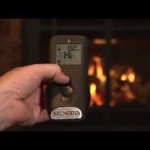How To Clean Fireplace Bricks
Maintaining a fireplace involves more than just safely operating it during colder months. A significant aspect of fireplace upkeep is the cleaning of the bricks, which tend to accumulate soot, ash, and creosote. Over time, this buildup not only detracts from the fireplace's aesthetic appeal but can also pose a fire hazard. This article provides a comprehensive guide on how to effectively clean fireplace bricks and maintain a safe and visually appealing hearth.
Before commencing any cleaning process, safety precautions are paramount. Ensure the fireplace is completely cool and has not been used for at least 24 hours. Gather necessary protective gear, including gloves, eye protection, and a dust mask or respirator. Soot and ash can be irritating to the skin, eyes, and respiratory system. Furthermore, adequate ventilation is crucial. Open windows and doors to promote airflow in the room. If possible, consider using a fan to exhaust the air outside.
Preparation is key to an efficient cleaning process. Cover the surrounding area with drop cloths or plastic sheeting to protect flooring, furniture, and nearby walls from potential spills and debris. A shop vacuum is ideal for removing loose debris such as ash and soot from the fireplace interior. Pay particular attention to corners and crevices where debris tends to accumulate. A stiff-bristled brush, such as a wire brush or scrub brush, can be used to further loosen stubborn deposits. After vacuuming, lightly dampen the bricks with water using a spray bottle or sponge. This prevents the soot from becoming airborne during scrubbing.
Choosing the Right Cleaning Solution
Selecting an appropriate cleaning solution is crucial for effective brick cleaning. Several options are available, ranging from commercial cleaners to homemade solutions. The choice depends on the severity of the soot buildup and the type of brick used in the fireplace. Avoid using harsh chemicals that could damage the brick or pose a health risk. Always test the cleaning solution in an inconspicuous area first to ensure it does not discolor or harm the brick.
Commercial brick cleaners are formulated specifically for removing soot and creosote. These cleaners often contain chemicals that break down the deposits, making them easier to remove. When using a commercial cleaner, carefully follow the manufacturer's instructions regarding dilution, application, and safety precautions. Ensure the cleaner is compatible with the type of brick in the fireplace. Some cleaners are designed for specific types of brick, such as firebrick or clay brick.
For a more environmentally friendly option, consider using a homemade cleaning solution. Several effective recipes utilize common household ingredients. One popular solution consists of mixing warm water with dish soap. The soap helps to loosen the soot, while the water rinses it away. Another effective solution involves mixing baking soda with water to form a paste. The baking soda acts as a mild abrasive, helping to scrub away stubborn deposits. For tougher stains, a solution of vinegar and water can be used. Vinegar's acidity helps to break down creosote and soot. However, it's important to note that vinegar can be corrosive, so use it sparingly and test it in an inconspicuous area first.
Another homemade option involves using trisodium phosphate (TSP), which is a powerful cleaner. However, TSP can be harmful to the environment and may require special handling. It's crucial to wear gloves and eye protection when using TSP, and to dispose of it properly. Before using TSP, research local regulations regarding its use and disposal. Some areas may restrict or prohibit its use due to environmental concerns.
The Cleaning Process
Once the cleaning solution has been selected and prepared, the cleaning process can begin. Apply the chosen solution to the bricks, ensuring thorough coverage. Use a spray bottle, sponge, or brush to apply the solution evenly. Allow the solution to dwell on the bricks for the recommended amount of time, typically 10-15 minutes. This allows the solution to penetrate the soot and creosote, loosening it from the brick surface. Avoid allowing the solution to dry on the bricks, as this can make it more difficult to remove.
After the dwell time, use a stiff-bristled brush to scrub the bricks. Apply firm, even pressure to remove the loosened soot and creosote. Pay particular attention to areas with heavy buildup. For stubborn stains, consider using a wire brush. However, exercise caution when using a wire brush, as it can scratch the brick surface if used too aggressively. Scrub in a circular motion to ensure thorough cleaning. Periodically rinse the brush with clean water to remove accumulated soot and debris.
After scrubbing, rinse the bricks thoroughly with clean water. Use a sponge, spray bottle, or hose to remove all traces of the cleaning solution. Ensure that no residue remains on the brick surface. Commercial cleaners, in particular, can leave behind a residue that can attract dirt and soot. Multiple rinses may be necessary to completely remove the cleaning solution. Blot the bricks dry with a clean cloth or towel. This helps to prevent water spots and allows the bricks to dry evenly. Allow the fireplace to air dry completely before using it.
During the cleaning process, it's important to monitor the condition of the bricks. If the bricks appear to be deteriorating or crumbling, stop cleaning immediately. Further cleaning could exacerbate the damage. Consult a professional for advice on repairing or replacing damaged bricks. Similarly, if the cleaning solution causes discoloration or damage to the bricks, discontinue its use and try a different solution. Always prioritize the preservation of the brick's integrity.
Addressing Stubborn Stains and Creosote Buildup
Despite thorough cleaning, some stains and creosote buildup may persist. Addressing these requires additional techniques and specialized products. Stubborn stains can often be removed with targeted cleaning using a paste of baking soda and water. Apply the paste to the stain, allow it to dry completely, and then scrub it away with a stiff-bristled brush. Repeat the process if necessary. For especially stubborn stains, consider using a poultice made of diatomaceous earth and water. Apply the poultice to the stain, cover it with plastic wrap, and allow it to sit for 24-48 hours. The diatomaceous earth will draw the stain out of the brick. Remove the poultice and scrub the area with a brush and water.
Creosote buildup can be particularly difficult to remove. Creosote is a flammable substance that forms when wood burns incompletely. It accumulates in the chimney and fireplace, posing a significant fire hazard. Regular chimney sweeps are essential for preventing excessive creosote buildup. However, some creosote may still accumulate on the fireplace bricks. Commercial creosote removers are available for cleaning fireplace bricks. These removers typically come in the form of sprays or pastes. Follow the manufacturer's instructions carefully when using creosote removers. Ensure adequate ventilation and wear appropriate protective gear.
For severe creosote buildup, consider hiring a professional chimney sweep. Chimney sweeps have specialized tools and equipment for removing creosote safely and effectively. They can also inspect the chimney for any structural damage or other potential hazards. Regular chimney inspections and cleanings are crucial for maintaining a safe and efficient fireplace. In addition to chemical treatments, steam cleaning can be an effective method for removing stubborn creosote deposits. Steam cleaning uses high-pressure steam to loosen and remove the creosote, without the need for harsh chemicals. However, steam cleaning should be performed by a professional with experience in cleaning fireplaces and chimneys.
After thoroughly cleaning the fireplace bricks, consider applying a sealant. A sealant helps to protect the bricks from future stains and makes them easier to clean. Choose a sealant that is specifically designed for use on brick and is compatible with the type of brick in the fireplace. Follow the manufacturer's instructions for application. Before applying the sealant, ensure the bricks are completely dry and free of any debris.
Maintaining clean fireplace bricks is an ongoing process. Regular cleaning, combined with proper fireplace maintenance, will help to keep the hearth looking its best and ensure a safe and enjoyable fire-burning experience. By implementing the techniques described in this article, homeowners can effectively clean their fireplace bricks and preserve the beauty and functionality of their fireplace for years to come.

How To Clean A Fireplace Diy Basics

How To Clean Fireplace Bricks 9 Steps With S Wikihow

How To Clean Brick The Home Depot

Best Way To Clean A Fireplace Stacy Risenmay

How To Clean Brick Fireplaces Mantels Hearths And More My Space

How To Clean Brick The Home Depot

How To Clean Brick Fireplace Royal Stone Care

How To Clean Fireplace Bricks Cleanup Team

How To Clean A Sooty Fireplace With Household Items Brick House Cleaning Tips

How To Clean Fireplace Bricks Simple Practical Beautiful
Related Posts








